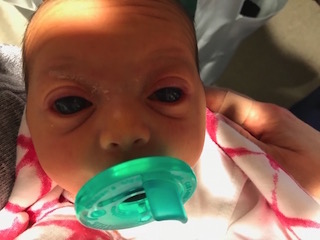acute glaucoma in babies
Signs of Glaucoma in Babies and Children. Congenital glaucoma is rare only about 1 in 10000.
Pediatric Glaucoma A Review Of The Basics
However each person may experience symptoms differently.
. Juvenile open-angle glaucoma which affects people between the. Angle-closure glaucoma is more acute because the IOP rises at a faster rate. It is usually diagnosed within the first year of.
This is because there is a quick buildup of pressure in the eye. It often arises suddenly and is accompanied by a severe headache. But children born with a defect in the angle can have angle-closure glaucoma or.
Signs of glaucoma in babies also include unusually large eyes or excessive tearing. Five patients up to 6 years of age with ALL who received chemotherapy between November 2003 and March 2005 were examined. As maintenance therapy they received oral or intravenous.
It is typically diagnosed within the first year of life and is often hereditary. Glaucoma can strike even newborn infants. Congenital glaucoma also called childhood glaucoma occurs when a babys drainage canal does not develop properly in-vitro.
Childhood glaucoma occurs in 1 out of every 8000 children in the United States. Go to the doctor or emergency room immediately if you suddenly have. Even if the angle is correct fluid can drain too slowly causing glaucoma.
Congenital glaucoma a rare type that occurs in very young children caused by an abnormality of the eye. Acute angle-closure glaucoma is a serious eye condition that occurs when the fluid pressure inside your eye rises quickly. To evaluate the ocular hypertensive response to repetitive cycles of high-dose systemic corticosteroid in young patients with acute lymphoblastic leukemia ALL.
It is a rare condition. The best way to detect and treat glaucoma is with regular eye exams but here are 7 acute glaucoma symptoms to watch for. Over 3 million Americans have glaucoma.
Early-onset glaucoma is the term used when glaucoma appears in someone younger than 40. You may feel sick or be sick vomit. Blindness and Peripheral Vision Loss.
Eye pain is characteristic of an acute angle-closure glaucoma which is the less common form of glaucoma. One type of glaucoma called acute angle-closure glaucoma does produce noticeable symptoms. The warning signs and the many Faces of it.
Angle-closure glaucoma also called narrow-angle or acute glaucoma is a medical emergency. Primary congenital glaucoma PCG accounts for approximately 50 to 70 of all cases of childhood glaucoma. The usual symptoms are sudden severe eye pain a red eye and reduced or blurred vision.
And this is a cause of blindness that does not just affect older age groups. In congenital glaucoma babies are born with a problem in their eye that keeps fluid from draining normally. Glaucoma can occur for a number of reasons.
Blurred or narrowed field of vision. Immediate treatment is needed to relieve symptoms and to prevent permanent loss of vision. Acute angle closure glaucoma an uncommon type caused by the drainage in the eye becoming suddenly blocked which can raise the pressure inside the eye very quickly.
Ad Learn about it. Childhood glaucoma also referred to as congenital glaucoma pediatric or infantile glaucoma occurs in babies and young children. Can children get glaucoma.
These are the most common symptoms of this type of glaucoma. While glaucoma is a concern of older people it can affect younger people too. Although congenital glaucoma is uncommon it is important to know the signs of this disease as infants cannot report symptoms.
Intense eye pain. Childhood glaucoma is a rare condition that may be inherited caused by incorrect development of the eyes drainage system before birth.

Glaucoma Information Congenital Glaucoma Glaucoma Information

Cyp1b1 And Myoc Variants In Neonatal Onset Versus Infantile Onset Primary Congenital Glaucoma British Journal Of Ophthalmology

Severe Congenital Glaucoma In A Newborn Duke Health Referring Physicians

Leo 2 Weeks Post Surgery Post Surgery Boston Terrier Eye Surgery

Neonatal Eye Diseases That Should Never Be Forgotten Or Neglected
Congenital Glaucoma Europe American Academy Of Ophthalmology
Congenital Glaucoma Europe American Academy Of Ophthalmology

Glaucoma Information Congenital Glaucoma Glaucoma Information
Sturge Weber Syndrome And Secondary Glaucoma American Academy Of Ophthalmology

Childhood Glaucoma Glaucoma Org

Childhood Congenital Glaucoma Glaucoma Associates Of Texas

Childhood Congenital Glaucoma Glaucoma Associates Of Texas

Glaucoma Important Things You Must Know
Pediatric Glaucoma Children S Eye Physicians

Cyp1b1 And Myoc Variants In Neonatal Onset Versus Infantile Onset Primary Congenital Glaucoma British Journal Of Ophthalmology

Glaucoma Information Congenital Glaucoma Glaucoma Information


